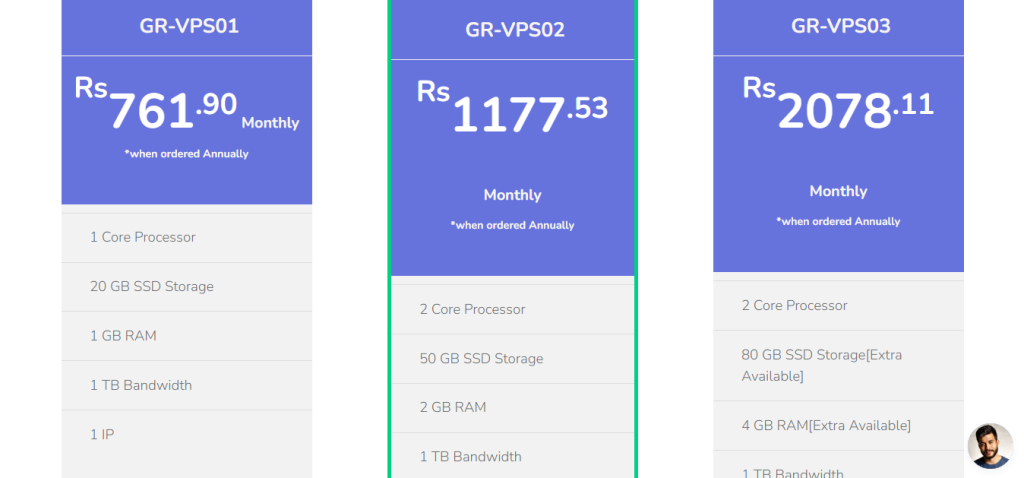Setting up a German VPS hosting environment can be a powerful way to manage your online presence. Whether you’re running a website, an application, or a business platform, a Virtual Private Server (VPS) offers a range of benefits including dedicated resources, greater control, and enhanced performance. This comprehensive guide will walk you through the process of selecting a provider, configuring your server, and optimizing performance to ensure a successful setup.

Table of Contents
1. Selecting a German VPS Hosting Provider

The first step in setting up your German VPS hosting is choosing the right provider. Here’s what you need to consider:
1.1. Research Providers
Start by researching different Germany VPS hosting providers. Look for providers with a strong reputation and positive reviews. Key factors to consider include:
- Reliability: Ensure the provider offers high uptime guarantees. Look for providers that offer at least 99.9% uptime to keep your services running smoothly.
- Support: Choose a provider with excellent customer support. Ideally, they should offer 24/7 support through multiple channels such as live chat, email, and phone.
- Pricing: Compare pricing plans and make sure there are no hidden fees. Consider providers that offer transparent pricing and good value for money. You can also opt for free web hosting.
- Features: Check the features offered by each provider. Look for essential features such as SSD storage, scalable resources, and robust security options.
1.2. Assess Your Needs
Determine your specific needs to find the right provider. Consider the following factors:
- Resource Requirements: Estimate the amount of CPU, RAM, and storage you need based on your website or application requirements.
- Traffic Expectations: Consider your expected traffic volume to ensure your VPS can handle it.
- Budget: Set a budget for your VPS hosting and look for providers that offer plans within your range.
1.3. Choose a Plan
Once you’ve narrowed down your options, select a VPS plan that best fits your needs. Most providers offer different tiers of plans with varying levels of resources and features.
2. Configuring Your German VPS Hosting Server
After selecting a provider and plan, the next step is to configure your German VPS hosting server. This involves several key tasks:
2.1. Accessing Your VPS
Once you’ve signed up with your provider, you’ll receive credentials to access your VPS. This typically includes:
- IP Address: The unique address of your VPS.
- Username and Password: Login credentials for accessing your server.
2.2. Initial Setup
- Log In: Use a Secure Shell (SSH) client to connect to your VPS. For example, you can use tools like PuTTY (for Windows) or Terminal (for macOS/Linux).
- Update Packages: Run updates to ensure your server is running the latest software. Use commands like
sudo apt updateandsudo apt upgradefor Debian-based systems orsudo yum updatefor Red Hat-based systems.
2.3. Configure Your Firewall
Securing your server is crucial. Set up a firewall to protect your server from unauthorized access.
- Install Firewall: Install a firewall if it’s not already installed. For example, you can use
ufwfor Ubuntu-based systems orfirewalldfor CentOS. - Configure Rules: Set up rules to allow essential traffic while blocking unwanted access. For example, allow HTTP (port 80) and HTTPS (port 443) while blocking other ports.
2.4. Set Up a Web Server
To host a website or application, you need a web server.
- Install Apache or Nginx: Choose between Apache and Nginx, two popular web servers. For Apache, use
sudo apt install apache2(Ubuntu) orsudo yum install httpd(CentOS). For Nginx, usesudo apt install nginx(Ubuntu) orsudo yum install nginx(CentOS). - Configure Virtual Hosts: Set up virtual hosts to manage multiple websites or applications on the same server. This involves editing configuration files and defining server blocks.
2.5. Install and Configure a Database
If your website or application requires a database, install and configure one.
- Install MySQL/MariaDB: For MySQL, use
sudo apt install mysql-server(Ubuntu) orsudo yum install mysql-server(CentOS). For MariaDB, usesudo apt install mariadb-server(Ubuntu) orsudo yum install mariadb-server(CentOS). - Secure the Installation: Run
sudo mysql_secure_installationto set up security measures such as removing the test database and setting the root password.
2.6. Set Up a Control Panel
A control panel can simplify server management. Popular options include cPanel and Webmin.
- Install cPanel: cPanel is a commercial control panel with a user-friendly interface. Follow the provider’s instructions for installation and configuration.
- Install Webmin: Webmin is an open-source alternative. Install it using
wget http://prdownloads.sourceforge.net/webadmin/webmin_1.981_all.debfollowed bysudo dpkg --install webmin_1.981_all.deb(Ubuntu).
3. Optimizing Performance for German VPS Hosting
To ensure your German VPS hosting environment performs optimally, follow these optimization tips:
3.1. Monitor Server Performance
Use monitoring tools to keep an eye on your server’s performance.
- Install Monitoring Tools: Tools like Munin or Nagios can provide real-time performance data. Install them using
sudo apt install muninorsudo apt install nagios3(Ubuntu). - Analyze Metrics: Monitor CPU usage, memory usage, and disk I/O to identify and address performance issues.
3.2. Optimize Web Server Configuration
Adjust your web server configuration to enhance performance.
- Enable Caching: Implement caching to reduce server load and improve response times. For Apache, use
mod_cacheand for Nginx, usengx_cache_purge. - Optimize Settings: Fine-tune settings such as the number of worker processes and connection limits based on your traffic patterns.
3.3. Secure Your Server

Security is crucial for maintaining server performance and protecting your data.
- Regular Updates: Keep your software up to date to protect against vulnerabilities. Set up automatic updates if possible.
- Use Strong Passwords: Ensure all passwords are strong and unique. Consider using a password manager to generate and store passwords securely.
3.4. Backup Your Data
Regular backups are essential for data protection.
- Set Up Automated Backups: Use tools like
rsyncorbackup.shto schedule regular backups. Store backups in a secure, offsite location. - Test Backups: Regularly test your backups to ensure they are working correctly and can be restored when needed.
3.5. Optimize Database Performance
Ensure your database performs efficiently.
- Indexing: Use proper indexing to speed up database queries. Analyze slow queries and optimize them as needed.
- Database Maintenance: Regularly perform maintenance tasks such as optimizing tables and cleaning up unnecessary data.
4. Tips Specific to affordable German VPS Hosting
4.1. Compliance with German Regulations
Germany has strict data protection laws, including the GDPR. Ensure your German VPS hosting provider complies with these regulations.
- Data Protection: Verify that your provider has measures in place to protect your data and comply with GDPR requirements.
- Data Sovereignty: Choose a provider that hosts your data within Germany to ensure compliance with local laws.
4.2. Leverage Local Data Centers
Choosing a provider with local data centers in Germany can enhance performance.
- Reduced Latency: Hosting your VPS in Germany reduces latency for local users, improving website loading times.
- Local Support: Providers with local data centers often offer better support for German customers, including support in the local language.
4.3. Consider Energy Efficiency

Germany is known for its commitment to sustainability. Look for providers that prioritize energy efficiency.
- Green Hosting: Choose providers that use renewable energy sources and energy-efficient data centers. This aligns with Germany’s environmental goals and can reduce your carbon footprint.
FAQs
1. What is German VPS Hosting?
Local German VPS Hosting refers to Virtual Private Server hosting services provided by companies based in Germany. It offers dedicated server resources, enhanced control, and better performance compared to shared hosting.
2. How do I choose the right German VPS Hosting provider?
To choose the right German VPS Hosting provider, consider factors such as reliability, support, pricing, and features. Look for providers with high uptime guarantees, excellent customer support, transparent pricing, and essential features like SSD storage and robust security.
3. What are the key steps to set up German VPS Hosting?
Key steps include selecting a provider, accessing your VPS, performing initial setup, configuring your firewall, setting up a web server, installing and configuring a database, and setting up a control panel.
4. How can I optimize the performance of my German VPS Hosting?
To optimize performance, monitor server performance, optimize web server configuration, secure your server, backup your data, and optimize database performance.
5. Are there specific considerations for German VPS Hosting?
Yes, specific considerations include compliance with German regulations (such as GDPR), leveraging local data centers for reduced latency, and considering energy-efficient hosting options.
Bonus Content: Advanced Tips for German VPS Hosting
1. Advanced Security Measures
1.1. Implement Intrusion Detection Systems (IDS)
An Intrusion Detection System (IDS) helps detect and respond to potential security threats.
1.1. Implement Intrusion Detection Systems (IDS)
An Intrusion Detection System (IDS) helps detect and respond to potential security threats.
- Install IDS Software: Consider using IDS software such as Snort or Suricata. These tools monitor network traffic for suspicious activity and can alert you to potential security breaches.
- Configure Alerts: Set up alerts to notify you immediately if any unusual activity is detected. This allows you to respond quickly to potential threats.
1.2. Use Two-Factor Authentication (2FA)
Two-Factor Authentication (2FA) adds an extra layer of security to your VPS login process.
- Enable 2FA: Configure 2FA for SSH access and any control panels you use. This requires users to provide a second form of authentication in addition to their password.
- Use Authenticator Apps: Consider using authenticator apps like Google Authenticator or Authy to generate 2FA codes.
2. Performance Tuning
2.1. Optimize Your Web Server
Fine-tuning your web server configuration can significantly improve performance.
- Configure Compression: Enable gzip compression to reduce the size of data transferred between your server and clients. For Apache, use
mod_deflate, and for Nginx, use thegzipdirective. - Leverage Browser Caching: Set up caching headers to instruct browsers to store static resources like images, CSS, and JavaScript files. This reduces the number of requests to your server and improves loading times.
2.2. Utilize Content Delivery Networks (CDNs)
A Content Delivery Network (CDN) can improve the delivery speed of your content to users worldwide.
- Choose a CDN Provider: Select a CDN provider such as Cloudflare or Akamai. These services cache your content on servers located around the globe, reducing latency for international users.
- Integrate with Your VPS: Follow the provider’s instructions to integrate the CDN with your German VPS hosting. This often involves configuring DNS settings and adjusting your server’s caching rules.
3. Backup Strategies
3.1. Implement a Comprehensive Backup Plan
Regular backups are crucial for data recovery in case of server failure or data loss.
- Schedule Regular Backups: Set up automated backups to run at regular intervals. Ensure that backups include all critical data, configurations, and system files.
- Use Multiple Backup Locations: Store backups in multiple locations, including offsite or cloud storage, to protect against data loss due to physical damage or server failure.
3.2. Test Backup Restorations
Regularly test your backups to ensure they can be restored successfully.
- Perform Test Restorations: Periodically restore backups to a test environment to verify their integrity and usability.
- Update Backup Procedures: Adjust your backup procedures as needed to accommodate changes in your data or infrastructure.
4. Scalability and Future-Proofing
4.1. Plan for Growth
Consider future growth when setting up your German VPS hosting.
- Monitor Resource Usage: Regularly review resource usage metrics to anticipate when you may need to scale up your server resources.
- Choose Scalable Solutions: Opt for VPS plans that offer easy scalability options. This allows you to upgrade your resources without significant downtime or migration efforts.
4.2. Evaluate Emerging Technologies
Stay informed about emerging technologies that can enhance your VPS setup.
- Explore Cloud Integration: Consider integrating cloud services with your VPS to leverage additional resources and features. Hybrid solutions can provide flexibility and scalability.
- Adopt New Security Practices: Keep up with the latest security practices and technologies to protect your VPS against evolving threats.
5. Localization and Compliance
5.1. Adhere to German Regulations
Ensure your German VPS hosting complies with local regulations.
- GDPR Compliance: Implement measures to comply with the General Data Protection Regulation (GDPR). This includes data encryption, secure data handling, and clear privacy policies.
- Local Data Centers: Verify that your provider’s data centers are located within Germany to meet data sovereignty requirements.
5.2. Optimize for Local Performance
Enhance the performance of your German VPS hosting for local users.
- Use Local DNS Servers: Configure your DNS settings to use local DNS servers for faster resolution of domain names.
- Optimize Local Content: Ensure that content is optimized for local audiences, including language settings and regional preferences.
Conclusion
Setting up and managing German VPS hosting involves careful planning and execution. By selecting the right provider, configuring your server correctly, and optimizing performance, you can ensure a reliable and efficient hosting environment. Advanced security measures, performance tuning, and scalability considerations further enhance your setup, providing a robust foundation for your online presence.
Stay informed about industry trends and best practices to maintain a high-performing and secure VPS environment. With these guidelines and tips, you’ll be well-equipped to set up and manage your German VPS hosting effectively.
FAQs
1. What is German VPS Hosting?
German VPS Hosting refers to Virtual Private Server hosting services offered by companies in Germany. It provides dedicated server resources, enhanced control, and better performance compared to shared hosting.
2. How do I choose the right German VPS Hosting provider?
To choose the right German VPS Hosting provider, consider factors such as reliability, support, pricing, and features. Look for providers with high uptime guarantees, excellent customer support, transparent pricing, and essential features like SSD storage and robust security.
3. What are the key steps to set up German VPS Hosting?
Key steps include selecting a provider, accessing your VPS, performing initial setup, configuring your firewall, setting up a web server, installing and configuring a database, and setting up a control panel.
4. How can I optimize the performance of my German VPS Hosting?
To optimize performance, monitor server performance, optimize web server configuration, secure your server, backup your data, and optimize database performance.
5. Are there specific considerations for German VPS Hosting?
Yes, specific considerations include compliance with German regulations (such as GDPR), leveraging local data centers for reduced latency, and considering energy-efficient hosting options.
Bonus Content: Advanced Insights on German VPS Hosting
1. Advanced Security Implementations
1.1. Conduct Regular Security Audits
Regular security audits help identify and address potential vulnerabilities in your German VPS hosting environment.
- Perform Vulnerability Scanning: Use tools like OpenVAS or Nessus to scan your server for vulnerabilities and misconfigurations.
- Review Security Policies: Regularly review and update your security policies and procedures to address new threats and vulnerabilities.
1.2. Implement Intrusion Prevention Systems (IPS)
An Intrusion Prevention System (IPS) can proactively prevent security threats.
- Deploy IPS Solutions: Consider deploying IPS solutions that work alongside your IDS to block malicious activity in real-time.
- Fine-Tune Rules: Adjust IPS rules to match your specific environment and threat landscape, ensuring optimal protection without affecting legitimate traffic.
2. Enhanced Performance Techniques
2.1. Optimize Web Application Performance
Improve the performance of web applications hosted on your German VPS.
- Use Application Accelerators: Implement application accelerators like Varnish or Redis to cache dynamic content and reduce server load.
- Optimize Code: Review and optimize your application code to eliminate performance bottlenecks and improve efficiency.
2.2. Implement Load Balancing
Load balancing helps distribute traffic across multiple servers, enhancing performance and reliability.
- Set Up Load Balancers: Use load balancing tools like HAProxy or Nginx to distribute traffic evenly across your servers.
- Monitor and Adjust: Continuously monitor the performance of your load balancers and adjust configurations as needed to handle changing traffic patterns.
3. Advanced Backup and Disaster Recovery
3.1. Develop a Disaster Recovery Plan
A disaster recovery plan ensures that you can recover from unexpected events.
- Create a Recovery Strategy: Develop a comprehensive strategy that outlines how to recover from various types of failures, including hardware failures, data corruption, and natural disasters.
- Conduct Regular Drills: Perform regular disaster recovery drills to test your plan and ensure that your team is prepared for real-life scenarios.
3.2. Use Incremental Backups
Incremental backups capture only the changes made since the last backup, reducing backup times and storage requirements.
- Implement Incremental Backups: Set up incremental backups to complement your full backups, ensuring efficient data protection without excessive storage use.
- Monitor Backup Processes: Regularly monitor backup processes to ensure that incremental backups are functioning correctly and that data is being protected as expected.
4. Customization and Automation
4.1. Automate Routine Tasks
Automation helps streamline server management and reduces manual errors.
- Use Automation Tools: Implement automation tools like Ansible or Puppet to manage server configurations, deploy updates, and perform routine maintenance tasks.
- Schedule Tasks: Set up automated schedules for tasks such as backups, updates, and monitoring to ensure they are performed consistently and on time.
4.2. Customize Server Environments
Tailor your server environment to meet specific needs and preferences.
- Create Custom Scripts: Develop custom scripts to automate specific tasks or configurations unique to your setup.
- Adjust Server Settings: Customize server settings to optimize performance for your particular use case, including adjusting resource allocations and tuning system parameters.
5. Compliance and Localization Best Practices
5.1. Ensure Compliance with Local Laws
Adhere to local laws and regulations to ensure your German VPS hosting is compliant.
- Understand Legal Requirements: Familiarize yourself with German laws related to data protection, privacy, and internet usage.
- Work with Legal Advisors: Consult with legal advisors to ensure that your server setup and practices comply with local regulations and standards.
5.2. Optimize for Local User Experience
Enhance the experience for users located in Germany by tailoring your German VPS hosting setup to their needs.
- Geolocation-Based Content Delivery: Serve content based on the user’s location to provide faster load times and relevant information. Use tools like MaxMind GeoIP to identify user locations and customize content delivery accordingly.
- Localization of Content: Ensure that your website content is available in German and follows local cultural norms and preferences. This includes translating text, using appropriate imagery, and considering local design aesthetics.
Conclusion
Setting up German VPS hosting involves a detailed and careful process, encompassing everything from choosing the right provider to optimizing server performance and ensuring compliance with local regulations. By following this comprehensive guide, you can effectively manage your German VPS hosting environment, providing a secure, reliable, and high-performing platform for your website or applications.
Remember to continuously monitor and optimize your VPS setup, stay updated with the latest best practices, and adapt to emerging technologies to maintain a robust and efficient hosting environment. With these steps and strategies, your German VPS hosting will be well-positioned to support your online endeavors.
FAQs
1. What is German VPS hosting?
German VPS hosting refers to Virtual Private Server hosting services offered by companies in Germany, providing dedicated server resources, enhanced control, and better performance compared to shared hosting.
2. How do I choose the right German VPS hosting provider?
To choose the right German VPS hosting provider, consider factors such as reliability, support, pricing, and features. Look for providers with high uptime guarantees, excellent customer support, transparent pricing, and essential features like SSD storage and robust security.
3. What are the key steps to set up German VPS hosting?
Key steps include selecting a provider, accessing your VPS, performing initial setup, configuring your firewall, setting up a web server, installing and configuring a database, and setting up a control panel.
4. How can I optimize the performance of my German VPS hosting?
To optimize performance, monitor server performance, optimize web server configuration, secure your server, backup your data, and optimize database performance.
5. Are there specific considerations for German VPS hosting?
Yes, specific considerations include compliance with German regulations (such as GDPR), leveraging local data centers for reduced latency, and considering energy-efficient hosting options.
Bonus Content: Advanced Insights on German VPS Hosting
1. Advanced Security Implementations
1.1. Conduct Regular Security Audits
Regular security audits help identify and address potential vulnerabilities in your German VPS hosting environment.
- Perform Vulnerability Scanning: Use tools like OpenVAS or Nessus to scan your server for vulnerabilities and misconfigurations.
- Review Security Policies: Regularly review and update your security policies and procedures to address new threats and vulnerabilities.
1.2. Implement Intrusion Prevention Systems (IPS)
An Intrusion Prevention System (IPS) can proactively prevent security threats.
- Deploy IPS Solutions: Consider deploying IPS solutions that work alongside your IDS to block malicious activity in real-time.
- Fine-Tune Rules: Adjust IPS rules to match your specific environment and threat landscape, ensuring optimal protection without affecting legitimate traffic.
2. Enhanced Performance Techniques
2.1. Optimize Web Application Performance
Improve the performance of web applications hosted on your German VPS.
- Use Application Accelerators: Implement application accelerators like Varnish or Redis to cache dynamic content and reduce server load.
- Optimize Code: Review and optimize your application code to eliminate performance bottlenecks and improve efficiency.
2.2. Implement Load Balancing
Load balancing helps distribute traffic across multiple servers, enhancing performance and reliability.
- Set Up Load Balancers: Use load balancing tools like HAProxy or Nginx to distribute traffic evenly across your servers.
- Monitor and Adjust: Continuously monitor the performance of your load balancers and adjust configurations as needed to handle changing traffic patterns.
3. Advanced Backup and Disaster Recovery
3.1. Develop a Disaster Recovery Plan
A disaster recovery plan ensures that you can recover from unexpected events.
- Create a Recovery Strategy: Develop a comprehensive strategy that outlines how to recover from various types of failures, including hardware failures, data corruption, and natural disasters.
- Conduct Regular Drills: Perform regular disaster recovery drills to test your plan and ensure that your team is prepared for real-life scenarios.
3.2. Use Incremental Backups
Incremental backups capture only the changes made since the last backup, reducing backup times and storage requirements.
- Implement Incremental Backups: Set up incremental backups to complement your full backups, ensuring efficient data protection without excessive storage use.
- Monitor Backup Processes: Regularly monitor backup processes to ensure that incremental backups are functioning correctly and that data is being protected as expected.
4. Customization and Automation
4.1. Automate Routine Tasks
Automation helps streamline server management and reduces manual errors.
- Use Automation Tools: Implement automation tools like Ansible or Puppet to manage server configurations, deploy updates, and perform routine maintenance tasks.
- Schedule Tasks: Set up automated schedules for tasks such as backups, updates, and monitoring to ensure they are performed consistently and on time.
4.2. Customize Server Environments
Tailor your server environment to meet specific needs and preferences.
- Create Custom Scripts: Develop custom scripts to automate specific tasks or configurations unique to your setup.
- Adjust Server Settings: Customize server settings to optimize performance for your particular use case, including adjusting resource allocations and tuning system parameters.
5. Compliance and Localization Best Practices
5.1. Ensure Compliance with Local Laws
Adhere to local laws and regulations to ensure your German VPS hosting is compliant.
- Understand Legal Requirements: Familiarize yourself with German laws related to data protection, privacy, and internet usage.
- Work with Legal Advisors: Consult with legal advisors to ensure that your server setup and practices comply with local regulations and standards.
5.2. Optimize for Local User Experience
Enhance the experience for users located in Germany by tailoring your German VPS hosting setup to their needs.
- Geolocation-Based Content Delivery: Serve content based on the user’s location to provide faster load times and relevant information. Use tools like MaxMind GeoIP to identify user locations and customize content delivery accordingly.
- Localization of Content: Ensure that your website content is available in German and follows local cultural norms and preferences. This includes translating text, using appropriate imagery, and considering local design aesthetics.
By implementing these advanced strategies, you can further enhance the performance, security, and user experience of your German VPS hosting. Stay proactive in optimizing and securing your server environment to ensure it remains robust and efficient in the long term.
